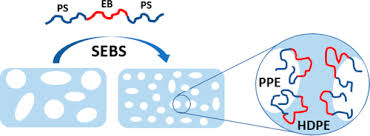In addition to having physical characteristics that are comparable to those of vulcanized elastomers, thermoplastic elastomers also offer special benefits such easy processing and recyclable materials. As a result, its progress has drawn a lot of interest. Styrene block copolymer elastomer is one of them and is a type of elastomer material with more varieties and a larger range of applications in thermoplastic elastomers. When compared to comparable products of styrene-butadiene-styrene block copolymer (SBS), hydrogenated styrene-butadiene-styrene block copolymer (SEBS) has a greater main chain saturation.The crosslinking effect in the unit volume of SEBS is quite great due to the high degree of entanglement of the polybutadiene block following hydrogenation. As a result, the modulus is high and it is difficult to degrade, therefore it is relatively low in the styrene block copolymer elastomer. a widely used product that is popular in many industries, including those that deal with food, medicine, leisure items, wires and cables, adhesives, coatings, and plastic modifiers.
SEBS has superior stability, heat resistance, oxidation resistance, weather resistance, and solvent resistance than SBS due to the high saturation of the main chain. Unlike SBS, which has a service temperature of just 65°C, SEBS has a service temperature of up to 130°C, and its processing temperature is substantially greater than that of polypropylene. A high-quality wire and cable material, SEBS is employed because of its effective electrical insulating qualities.

A variety of polymers, including PP, polystyrene (PS), high-density polyethylene (HDPE), polycarbonate (PC), polyamide (PA), polyphenylene oxide (PPO), and others can be mixed with SEBS due to its superior blendability. Mixed, and can significantly boost the effectiveness of its influence. The product is more transparent once SEBS, paraffin oil, naphthenic oil, and PP are combined together.
The amide group on the main chain of PA has strong polarity and can form hydrogen bonds to promote crystallization, making it have good wear resistance and solvent resistance, but at the same time it also increases the hygroscopicity of PA, which affects the dimensional stability of the product. In the PA/PP/SEBS and maleic anhydride (MAH) grafted SEBS (SEBS-g-MAH) system. In a dry condition and at low temperatures, PA has poor impact performance and has a low elastic modulus. By blending PP in, you may lower the cost while simultaneously enhancing the effectiveness and reducing the hygroscopicity of PA.However, the impact of blending adjustment is weak since PP does not have good thermodynamic compatibility with highly polar PA. Increased interfacial adhesion is possible with MAH-grafted materials like EPDM (EPDM-g-MAH), SEBS-g-MAH, etc. by using the reaction between the polar amide group on the PA main chain and the MAH-grafted compatibilizer. The hard SEBS-g-MAH is a more effective blend compatibilizer when compared to the soft EPDM-g-MAH and may significantly increase the strength and toughness of the PP/PA6 mix without compromising its hardness.The distribution of SEBS-g-MAH in the PA matrix and the PA/PP boundary fabric serves two purposes:
(1) Increase the elastomer volume percentage to have a toughening impact; (2) Produce more elastomer-PA graft copolymers to have a surfactant-like effect and aid in PP/PA’s interfacial adhesion.
This demonstrates how a blend material with a good balance of stiffness and toughness can be produced utilizing proper management of the constituent ratio and the use of SEBS-g-MAH as a compatibilizer.
This demonstrates that the new elastomer SEBS is an excellent plastic modifier and compatibilizer, especially after functionalization (such as maleic anhydride, sulfonation, chloromethylation, and methylolation), which demonstrates exceptional compatibility with particular systems and significant application value.











